4
State Government Uses of Native Seed
INTRODUCTION
In the first phase of the assessment leading up to its interim report, the committee heard that native seed shortages in the commercial market were caused by agencies such as the Bureau of Land Management (BLM) buying up all the available seed after wildfires. It put forward the hypothesis that the seed market in the West was strongly affected by decision making of BLM and the US Forest Service, and wanted to know if state governments, which also purchase native seed for land-management activities, were experiencing shortages, and if so, whether this phenomenon was limited to the western states or was more widespread.
The Committee felt that a survey of state departments that use native seed or plant materials might shed light on some of the Committee’s other preliminary observations about native seed needs, such as how the timeframe in which seeds are needed and the objectives of users affect availability, among other factors (Box 1-2). The Committee felt that a perspective from state governments would provide another lens with which to assess how well the native seed supply functions across the nation. This chapter presents the survey findings.
Chapter 2 describes the survey methodology. The Committee sent surveys to an average of three government departments in each state likely to use native plant seed and plant materials (to include seedlings, mature plants, and other vegetative materials). As indicated in Chapter 2, this was not a comprehensive list of all state government departments in the United States, so the results cannot be generalized to all such departments. These responses reflect the opinions of the sample that was generated by National Academies of Sciences, Engineering, and Medicine staff based on an internet search of state government webpages to identify those with responsibilities related to land management, fish and wildlife habitat, parks and recreation, roadside vegetation and maintenance, and natural heritage conservation. The departmental staff who responded to the survey were asked to answer questions about the use of seed in the department’s work. The staff was also asked about their individual roles related to their department’s purchase or use of seed, including project planning, providing biological expertise, purchasing or contracting, project management, or fieldwork (such as site preparation, seeding, and monitoring). Figure 4-1 shows that at least three out of four respondents were involved in planning, advisory, and management roles, while slightly fewer than three out of four were involved in purchasing or fieldwork. The spread across areas shows many respondents appear to have played multiple roles.
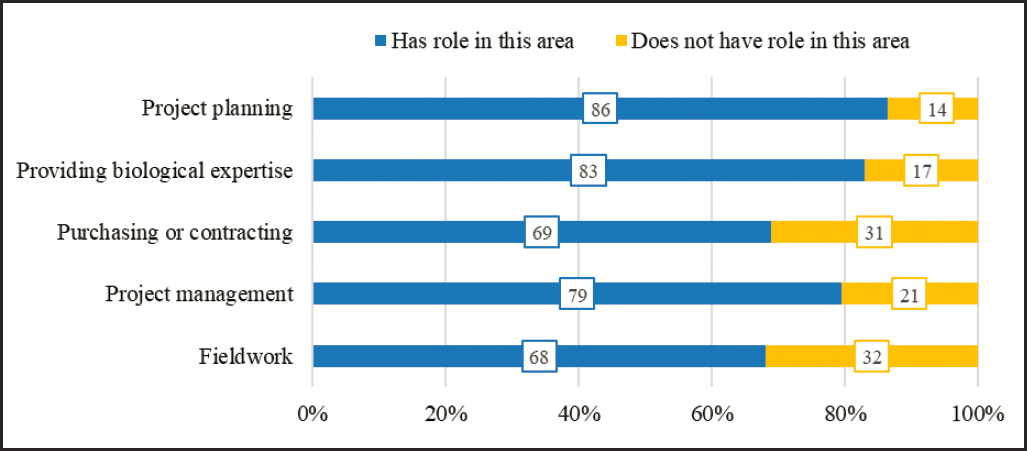
Native and Non-native Seed Use
Most state departments surveyed use both native and non-native seeds and plant materials (other than seed) in their projects. Almost 95 percent of respondents to the committee’s survey indicated that their department uses native seed or native plants, while three-quarters (74%) of the departments use non-native seed and two-thirds (65%) use non-native plants. About one-fourth of the departments who responded to the survey do not use non-native seed at all and more than a third do not use non-native plants (Figure 4-2).
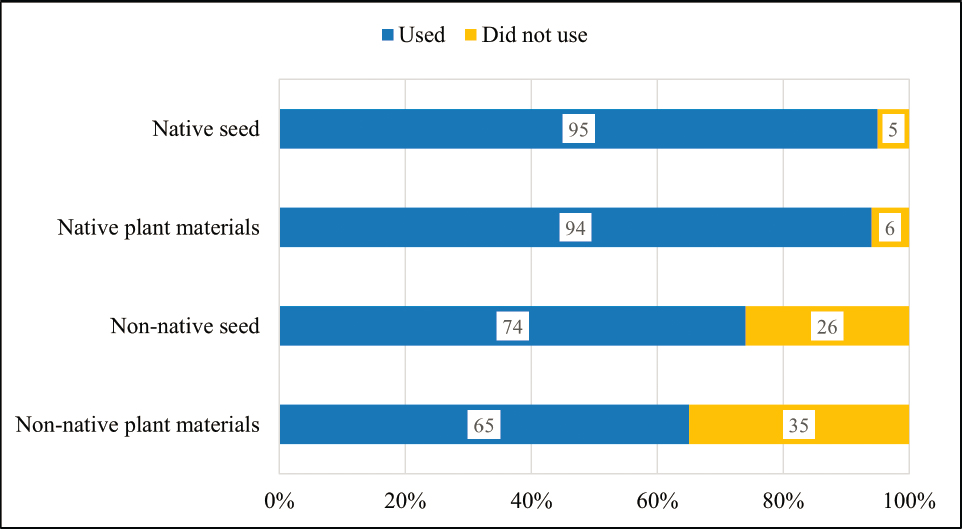
TABLE 4-1 State Departments’ Use of Native Seed or Plant Materials for Specific Purposes
| Purpose of Use | Percent of Departments |
|---|---|
| Creation or restoration of wildlife habitat (other than pollinator habitat) | 87 |
| Pollinator habitat projects | 83 |
| Stream erosion mitigation or restoration | 80 |
| Restorative activity on land in a wilderness or natural area | 75 |
| Soil protection | 72 |
| Invasive species suppression | 59 |
| Roadside seeding | 67 |
| Landscaping | 61 |
| “Green” infrastructure | 49 |
| Roadside maintenance | 47 |
| Natural disaster recovery | 37 |
| Another purpose | 31 |
Most of the survey questions focused on issues related to the use of native seed and plants. To provide a consistent reference timeframe, respondents were asked to focus on projects carried out by between 2017 and 2019.
For example, the survey provided a list of purposes and asked if the department used native seed or plant materials for any of these purposes between 2017 and 2019 (Table 4-1). Appendix 2C shows the exact wording of all of the questions.
When asked about “another purpose” for uses of native seed or plant material, topics mentioned included public education/giveaways, used to restore riparian and wet meadows, provided to producers for seed increase, coastal zone protection, forest management, screening, and the sale of native tree and shrub seedlings for conservation. The survey did not ask if non-native seed or plants were used for these same purposes. When asked if their states have programs to assist private landowners with the use of native seed or plant materials, about half (46%) of the state respondents indicated that they did.
Where Do Departments Obtain Seeds and Plant Materials?
Nearly all the state departmental respondents (96%) who were asked the question said that commercial suppliers are among the sources their department uses to buy native seed or plant materials. Approximately two out of three (63%) said that they obtained native seed or plant materials from project collaborators, and half (49%) said that they collect or grow their own (Figure 4-3).
Collection of Native Seed from State Land and How the Collected Seed Was Used
Figure 4-4 shows that just under half (44%) of the respondents said that the native seed they used between 2017 and 2019 included seed that was wild collected on state land (29% were unsure of whether the seed used had been collected on state land). Of those respondents who responded that wild seed was collected on state land, 92 percent said that at least some of the seed was used to plant directly at a project site, and 79 percent said that at least some of the seed was used to grow plants with the purpose of harvesting seed or plant materials for future use.
When asked about “Other” uses of wild collected seeds from state land, the answers included harvested and given out to landowners, grown into seedlings for sale to residents, frozen for storage or given to seed banks for future use, and used for projects on partner lands.
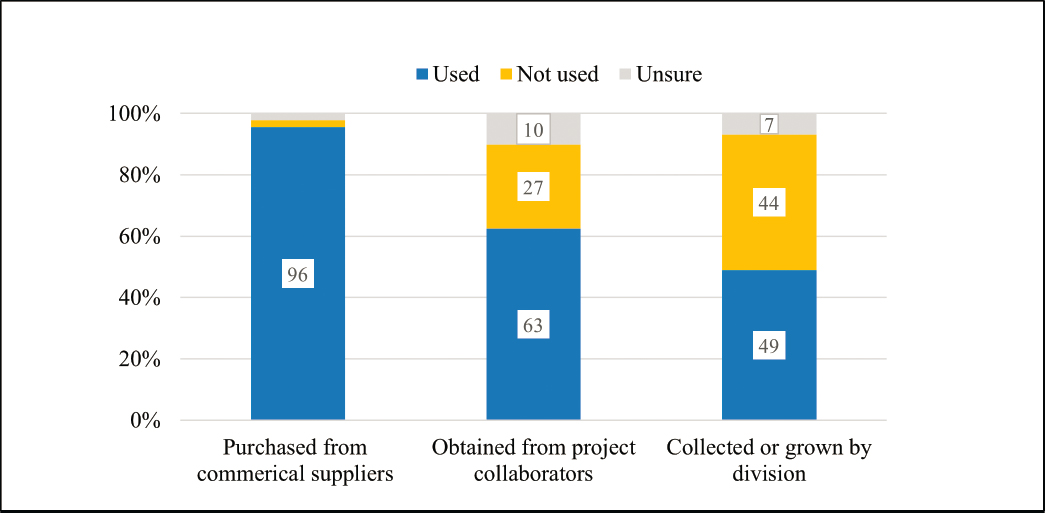
Ambient, Refrigerated, and Frozen Storage
Respondents were asked about the availability to their departments of different types of seed storage. Sixty-four percent said they had ambient storage space, 28 percent had refrigerated storage, and 16 percent had freezer storage of some kind (13% were unsure about whether they had refrigerated storage and 15% were unsure about freezer storage).

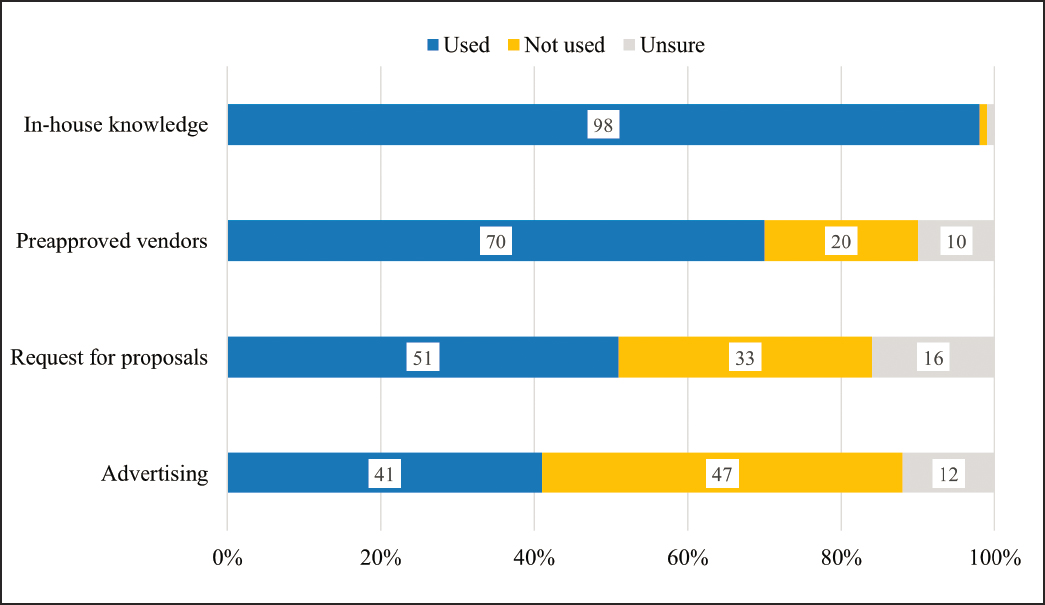
Sources of Information about Native Seed and Plant Materials Availability
Respondents were given a series of questions asking whether a given option is used as a source of information to find out about the availability of native seed and plant materials. The options included in-house knowledge, advertising (about needs), preapproved vendors, or requests for proposals. Figure 4-5 shows that 98 percent of departments rely on in-house knowledge to find the seed and plant materials. Preapproved vendors and Requests for Proposals are used by most departments, while advertising is the least common method.
Departmental representatives were asked if there were other sources of information used to obtain information about native seed and plant materials availability. Responses included direct calls to vendors, annual meetings with registered suppliers, online vendor postings, other state departments, state crop associations, state university extension offices, native plant databases, BLM seed buys, and state seed bank.
Relationships with Suppliers
How Seeds Are Obtained from Commercial Suppliers
Among those who said that their departments bought native seed or plant materials from commercial suppliers, 81 percent of the respondents said that this involved purchases directly on the open market, and 66 percent said that purchases were made via a formal bidding process. To gain a sense of the differences between eastern and western states, the responses were compared by region. As described in Chapter 2, the survey included a relatively small number of departments, and therefore the comparisons by region should be interpreted with caution.1Figure 4-6 shows
___________________
1 East includes AL, AR, CT, DE, FL, GA, IA, IL, IN, KS, KY, LA, MA, MD, ME, MI, MN, MO, MS, NC, ND, NE, NH, NJ, NY, OH, OK, PA, RI, SC, SD, TN, TX, VA, VT, WI, WV; West includes AK, AZ, CA, CO, HI, ID, MT, NM, NV, OR, UT, WA, WY.

that in the eastern states, a larger percentage of departments appear to use purchases from the open market (87%) as compared to 69 percent in the western states. In addition, 63 percent of respondents located in the eastern states said that they use the bidding processes while this value was 70 percent in the western states.
Marketing Contract and Production Contracts
Respondents were asked about contracting arrangements, and specifically whether their department used marketing and/or production contracts to procure seeds from suppliers. Marketing contracts specify the type, price, quantity, and delivery date of seed or plant materials. By contrast, production contracts specify the desired type, quantity, and delivery date of native seed and plant materials, while mitigating production risk by sharing some production costs or by providing flexibility on the quantity delivered and/or the delivery date. They may or may not specify a price. Only 22 percent of departments said that they used production contracts, compared with 39 percent who used marketing contracts (Figure 4-7). Marketing contracts may offer more certainty to buyers and sellers, but production contracts might be used to encourage growers to take on the production of a difficult-to-grow species. About 18 percent of state respondents were unsure if marketing contracts were used and about 25 percent were unsure if production contracts were used. This is consistent with the variety of different positions and responsibilities held by respondents who may lack individual knowledge about the purchasing process.
Timing of Contracts Relative to Production
Two out of five respondents from the state departments were unsure about whether the contracts are established before or after the supplier begins the seed production process. Thirty-seven percent said that the contract was usually established before the supplier begins the seed production process, and 24 percent said that it was after (Table 4-2).
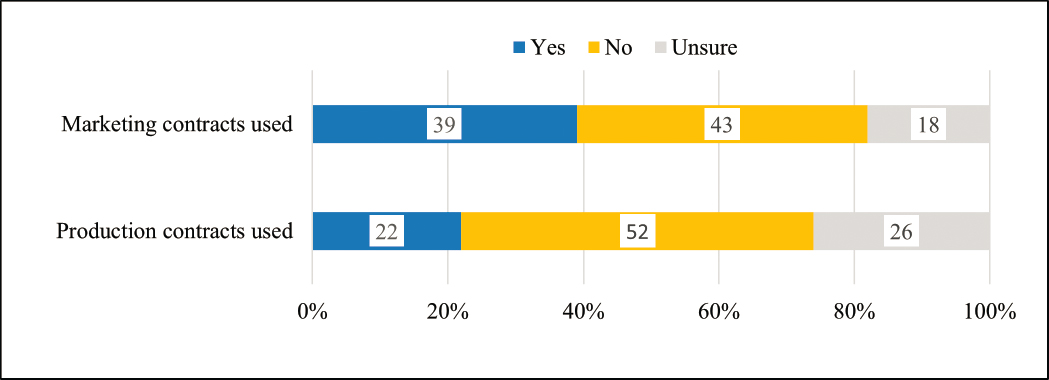
Communicating Future Seed Needs to Suppliers
No single method dominated the state departments’ methods of communicating their anticipated future needs to suppliers. Approximately half of the respondents mentioned word of mouth (55%), requests for proposals (49%), conferences or other professional meetings (49%), and informal meetings with growers (45%).
Importance of Seed Attributes
Departmental representatives were asked to reflect on projects between 2017 and 2019 and to indicate how important it was to obtain seed with the following attributes: native seed; native seed sourced from a specific geographical location or seed zone; and certified native seed. Nearly all departments nationwide indicated that native seed was very important or somewhat important. As Figure 4-8 shows, a higher proportion of departments in western states indicated that native seed was very important (90%) relative to departments in eastern states (79%). Departments in western states were also more likely to view native seed sourced from a specific geographical location or seed zone as very important (57%) relative to eastern states (46%). The responses with respect to certified seed were similar across the country: 42 percent of departments from East and 43 percent of departments from the West indicated that certified native seed was very important.
Responses were also compared based on the departments’ average annual expenditures on native seed and plant materials. Similar to the geographic comparisons, the comparisons by the level of expenditure should be interpreted with caution due to the small sample size. In addition, approximately 10 percent of the state respondents were unable to provide an estimate of the amount their department spends on native seed and plant materials, and some respondents skipped this question.
TABLE 4-2 Timing of When State Departments Usually Establish a Contract with Seed Suppliers
| Contract is Usually Established | Percent of Departments |
|---|---|
| Before the supplier begins seed production | 37 |
| After the supplier begins seed production | 24 |
| Unsure of timing of contract | 39 |
| Total | 100 |
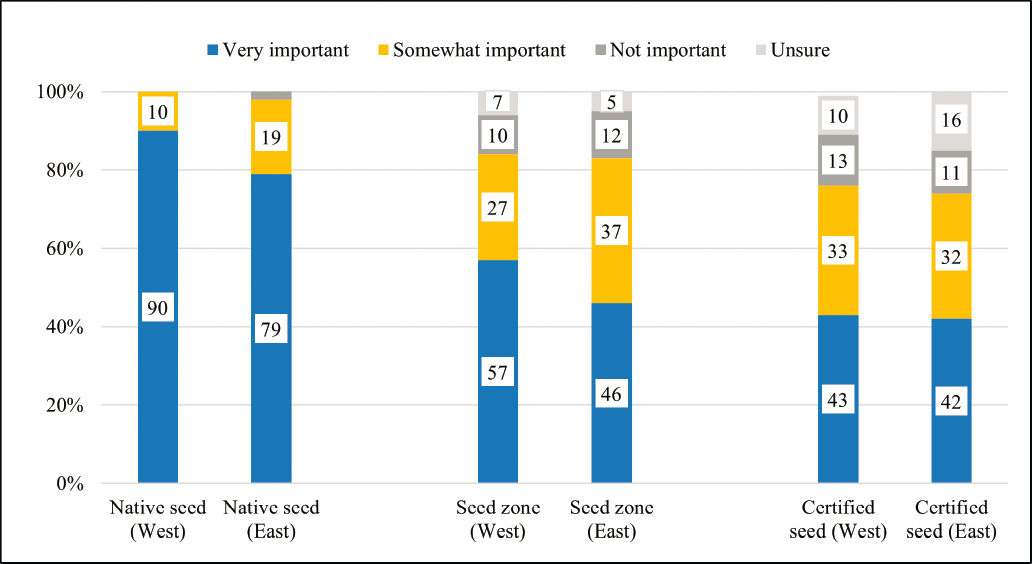
When responses were examined relative to the level of departments’ annual expenditures on native seed and plant materials, those with larger annual expenditures (over $100,000) were generally somewhat more likely than those with small annual expenditures ($100,000 and under) to indicate that each of the three seed attributes were very important. Figure 4-9 shows that certified seed was very important to departments with larger expenditures (54%) relative to departments with smaller expenditures (31%).
In general, the results show that using native seed was more important to states than using native seed sourced from a specific geographic location or certified seed (in which the geographic source of the originally collected seed was verified
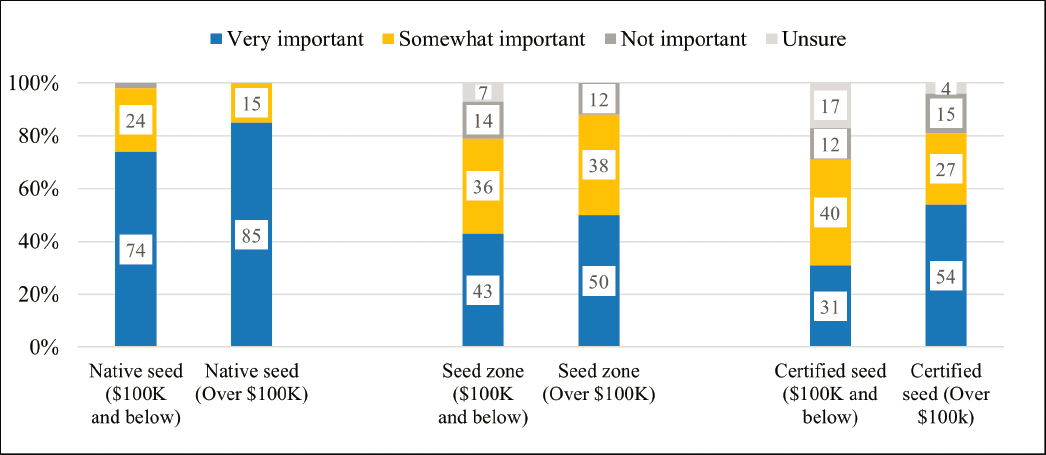
TABLE 4-3 Other Seed Attributes Specified as Important by State Departments
| Desired Attributes | Number of Responses |
|---|---|
| Genetic appropriateness | 7 |
| Weed-free | 6 |
| % Purity | 6 |
| High germination rate | 6 |
| Prior track record | 6 |
| Other | 6 |
| Cost | 5 |
| Total | 42 |
by a certification agency, along with the genetic integrity of subsequent generations of increase. Seed certification is not required for the sale of seed (in contrast to seed viability analysis; see Chapter 8), but it is sometimes required by buyers. The cost of certified seed is a little more than non-certified seed because of the fee associated with certification.
Departments were asked to list other characteristics of seed obtained during 2017–2019 that were important. Table 4-3 is a summary of responses received.
Attributes mentioned related to basic market conditions included cost (5), quantity (2), and availability (2). Cost corresponds to price (cost per unit), or price multiplied by quantity (total cost). Many other attributes mentioned regard quality dimensions that are independent (or potentially independent) of source specificity, e.g., weed-free, with genetically appropriate mentioned most often.
Seed Substitutions
State representatives were asked questions about how often their departments substituted other kinds of seed or plant materials when their preferred native seed or plant material was unavailable, specifically substituted with non-native seed or plant material, native seed or plant material of another species, or native seed or plant material from a different geographic region. In some cases, the responses to different kinds of substitutions varied regionally or according to the level of a department’s annual seed expenditures. Figure 4-10 shows how departmental representatives across all states answered these questions.
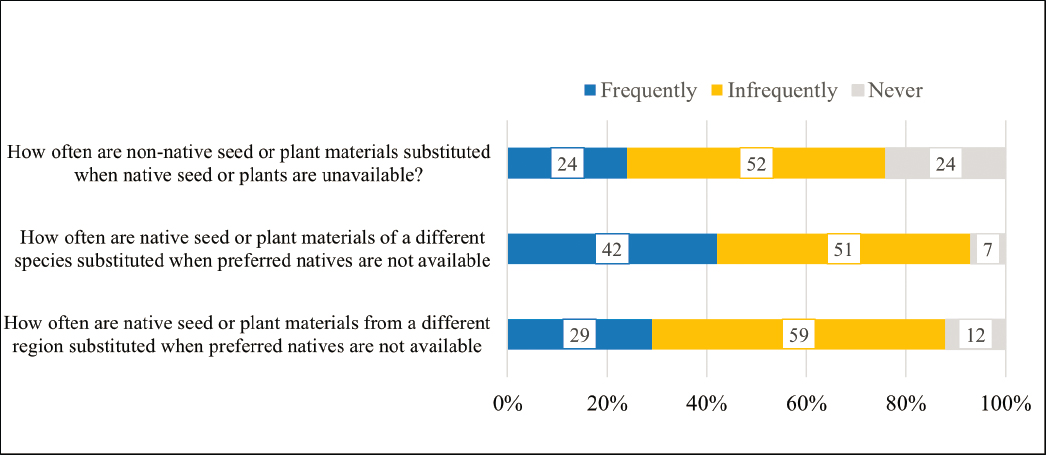
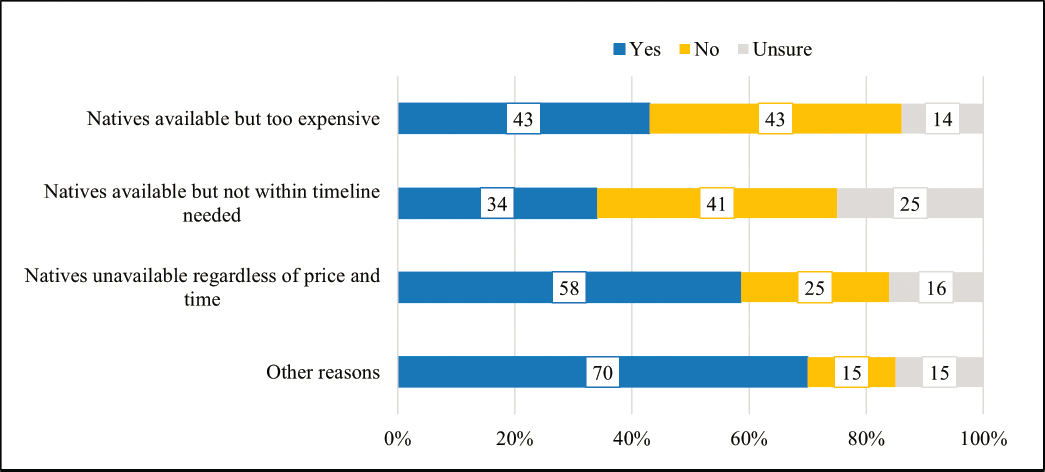
Substituting Non-Natives for Natives
The responses of state representatives, asked how often their departments substitute non-native seed or plant materials when native seed or plants are unavailable, was examined by region and by the level of annual expenditures of a state department ($100,000 and below, or over $100,000). The responses were similar by region and size and the overall national numbers. About a quarter (24%) of departments frequently substitute with non-natives, and about half said that they substitute non-natives infrequently. A quarter (24%) indicated that their agency never substitutes non-natives for natives, even if natives are unavailable.
Respondents from those departments that said that they substituted non-native seed or plant materials (either frequently or infrequently) were asked about several potential reasons for the substitutions: native seed or plant material were available but too expensive; native seed or plant material were available but not within the timeline needed; and native seed or plant material were unavailable regardless of price and timing. Figure 4-11 shows the agency responses overall. The most commonly cited reason by state departments overall (58%) was that native seed or plant material were unavailable regardless of price and timing. The second most cited reason was that preferred natives were available but too expensive (43%). Timing considerations were cited by 34 percent. Approximately two out of five respondents cited at least two of these three market-related reasons, and a fifth of respondents cited all three reasons, meaning that they cited price and timing reasons as well as “unavailable regardless of price and timing.” One potential explanation for this finding is that some native seed species were entirely unavailable, while others were available but costly or at the wrong time.
Figure 4-12 shows responses by region to the questions about reasons for substitution with non-natives. Departments in western states found cost, availability, or both to force a substituting with non-natives 50 to 70 percent of the time, versus 26 to 52 percent in the East. Notably, 70 percent of departments in the West encountered situations when native seed or plant material were unavailable regardless of price and or in the timeframe needed.
Other Reasons for Substituting with Non-natives
In an open-ended question, state staff were also asked if there were other reasons besides the three offered by the survey that explain why non-native seeds and plant materials were substituted when preferred natives are not available. Table 4-4 provides a summary of the reasons given, grouped into categories.
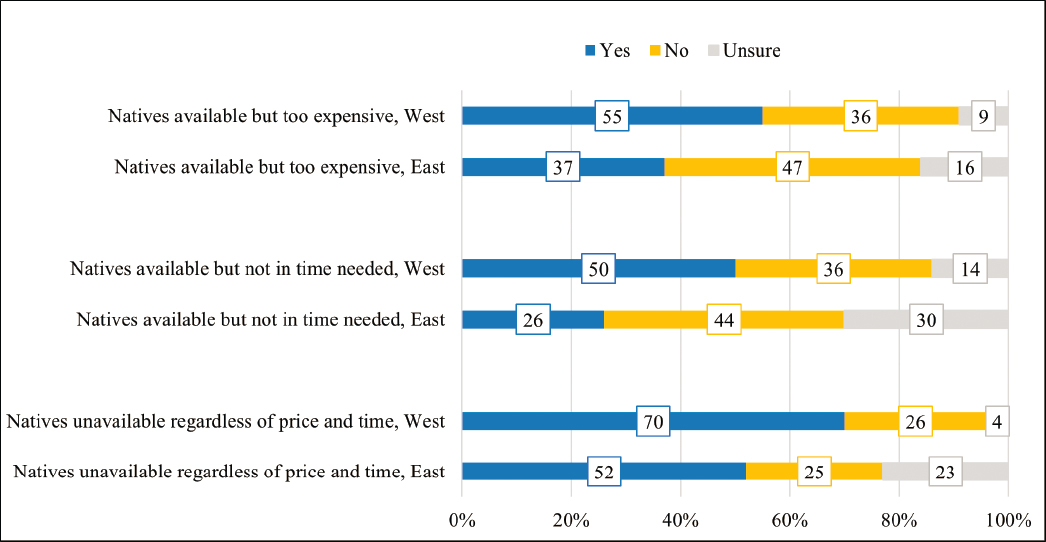
Substituting with Natives of a Different Species or from a Different Region
When preferred native seed or plants are not available, departments sometimes substitute with native seed or plant materials having different characteristics. As shown in Figure 4-13, 42 percent of the respondents stated that they frequently substitute with native seed or plant material of different species, and this was similar for eastern and western states. When the responses were examined by the level of annual expenditure on seeding projects, 50 percent of state departments with $100,000 or more in expenditures indicated that they frequently substitute with
| Reason for Substitution (Categories) | Description of the Types of Reasons Given in Each Category | Number of Responses |
|---|---|---|
| Effectiveness | Non-native seed or plant materials are associated with better performance with respect to areas prone to erosion, such as near infrastructure or buildings, on steep slopes, for soil stabilization. Non-natives are associated with a stronger ability to compete with invasive species. Non-natives meet requirements to provide a % ground cover. Better performance of mixtures. |
10 |
| Specific purpose | Non-native seeds and plants are specifically selected for ornamental and fruit trees, landscaping, and agricultural plantings, and for wildlife food/forage. | 7 |
| Preference for non-natives | Land manager discretion, preference, previous experience, lack of knowledge of natives, lack of options | 6 |
| Other | Seed offered was not certified, insufficient quantities available, poor seed quality/viability, lack of ecoregional genotypes, no inexpensive native forbs | 5 |
| Total | 28 |
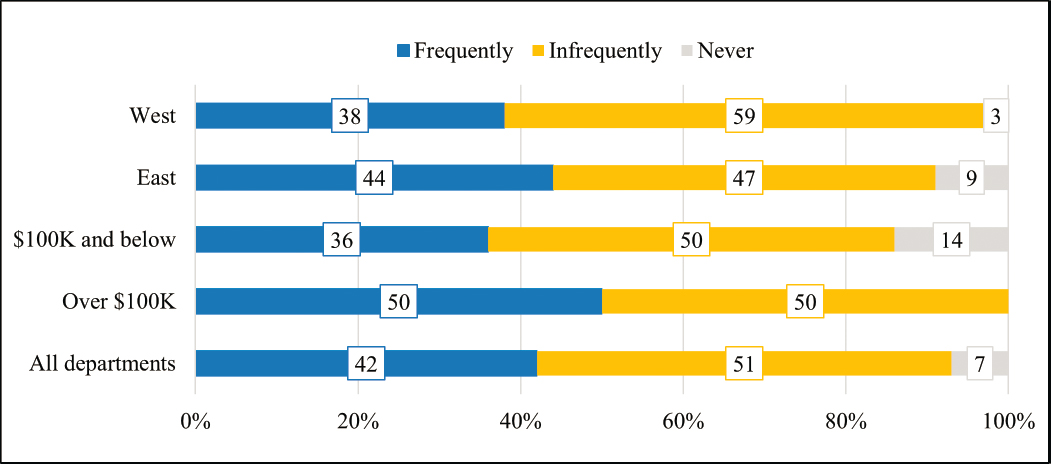
natives of different species versus 36 percent of departments with expenditures of $100,000 or below. This suggests that those departments with larger projects may have more difficulty getting the quantity of natives they need.
As shown in Figure 4-14, 29 percent of state representatives responding to the survey indicated that their departments frequently substitute with native seed or plant materials from a different geographical source location when their preferred native seed or plant materials are not available. Examined on a regional basis, 45 percent of respondents from western states substitute with natives from a different geographical location, versus 21 percent from eastern states. One possible explanation for this difference is that there is a greater diversity of landscapes and seed zones in the West so it may be harder for suppliers to provide a sufficient diversity of ecotypes to meet all needs. The responses were similar across state departments with different levels of annual expenditures on seed.

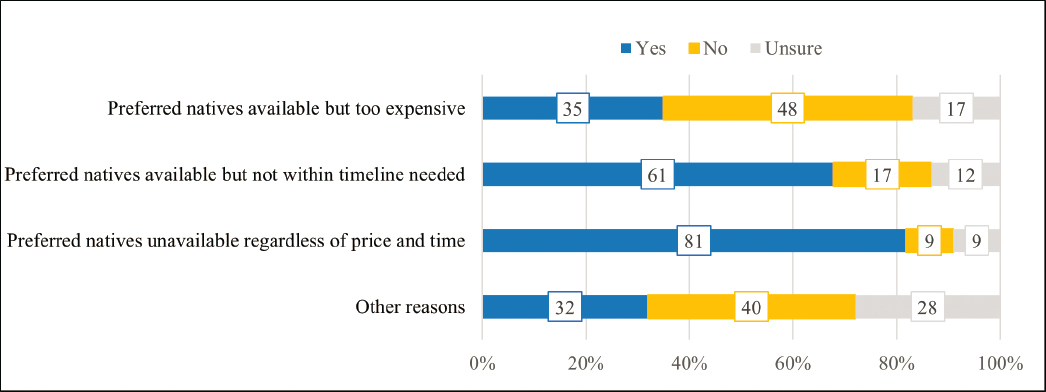
Among the reasons for substitutions with natives having different characteristics, the lack of availability regardless of price or timing was mentioned by 81 percent of respondents overall, lack of availability within the timeframe required by 61 percent, and price by 35 percent (Figure 4-15). All three reasons were cited by 25 percent of respondents. Unavailability was cited in conjunction with one of the other reasons more than half of the time. Thus, the respondents citing unavailability and at least one other reason are a substantial share of the 81 percent reporting unavailability as a reason. Almost half of respondents (48%) indicated that the price of available seed was not a reason.
Figure 4-16 shows that the lack of availability appears to be a bigger challenge for departments in the West than the East. Lack of availability in the time needed was mentioned by a higher proportion of respondents in the West (79%) versus the East (51%). It is possible that buyers in western states have smaller windows of time for purchasing seed
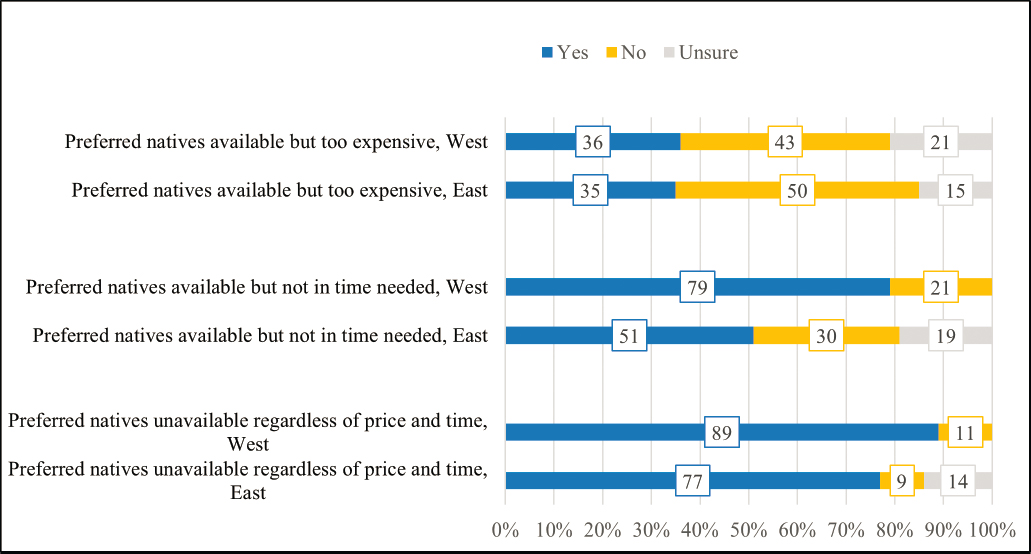
than those in the eastern states, due to the need to obtain seed for emergency stabilization after wildfire, for example. About one in three staff in both the East and West indicated that substitutions with native seeds of other species or from other regions were made because the seeds they wanted were available but too expensive. Eighty-nine percent of state staff in the West and 77 percent in the East said that substitutions were made because the preferred seeds were unavailable regardless of price and timing. Departments with seed expenditures over $100,000 were more likely (92%) to say that substitutions with native seed with other characteristics were made because preferred seed were unavailable regardless of price and timing than departments with seed expenditures of $100,000 and under (78%) (data not shown).
Biggest Barriers to Using Native Seed
When asked (in the form of an open-ended question) about the biggest barriers or disincentives to using native seed and plant materials in the state departments’ work, approximately half of the respondents mentioned availability of plant material (48%). The second most frequently mentioned barrier or disincentive was price (38%). These two reasons are interdependent in a market. If buyers, such as these survey respondents, are unwilling or unable to pay a price that at least covers the suppliers’ cost of production or collection for some species then none of the desired seed will be produced. In turn, buyers will experience a lack of availability. Because nothing is produced, buyers will perceive the outcome as “unavailable regardless of price and timing.” Likewise, if buyers fail to signal their intent to purchase seed of designated species in time to produce that seed, suppliers may deem it too risky to incur production costs with the market in doubt. Both of these reasons for unavailability result from market forces.
Expertise and Labor
Monitoring Seeding Projects
Most state respondents said that they check on the survival of the seed or plant materials after planting for most or some of their projects (72% do this for most projects and 26% do this for some projects). These responses were also examined by region: 80 percent of the respondents in the West said that they do this for most projects, compared to 67 percent in the East. As shown in Figure 4-17, 27 percent of departments in the East check on survival of seeding or
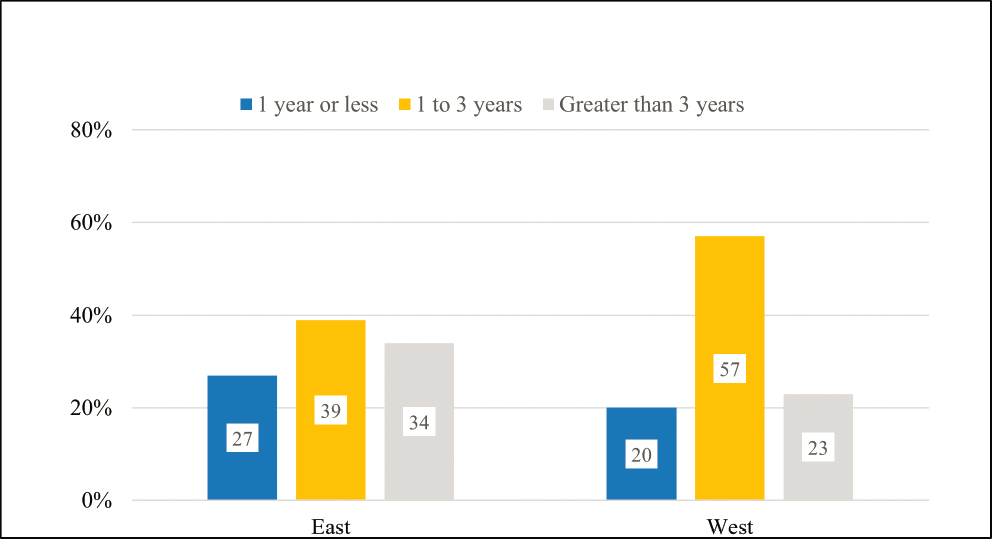

planting projects for a year or less, versus 20 percent of departments in the West. A final survival check was typically completed within 1–3 years by 57 percent of departments in the West versus 39 percent in the East. About a third of departments in the East and about a quarter of departments in the West continue to monitor seedings and plantings for survival for greater than 3 years.
In-House Expertise and Gaps in Expertise
Department representatives were asked whether they have the range of in-house expertise needed for the various aspects of projects that use native seeds or plants. Overall, 58 percent said that they have the expertise needed, and 39 percent said that they had some gaps in expertise (the remaining 3% did not know). Responses to this question did not differ by region (57% said that they had the needed expertise in the West and 59% said the same in East). Responses were also examined by the amount of annual native seed and plant materials expenditures of the department (Figure 4-18). Those with larger annual expenditures were more likely to have in-house expertise than those with smaller expenditures (77% of the departments with budgets over $100,000 said that they had the expertise compared to 47% of the departments with budgets of $100,000 and under).
Those who said that they had some gaps in in-house expertise were asked to describe the expertise they were missing. In addition to mentions of inadequate levels of staffing, the responses covered a broad range of gaps in specialized knowledge, including agronomy, seed production, propagation protocols, and collection methods, native plant species identification, and planning for seeding with natives and maintenance. Some respondents said that they were able to meet their needs with various forms of collaborations with outside experts, and some clarified that the gaps only affect certain parts of the state.
Role of Policy in Decision Making
Most respondents said that a variety of specifications and guidelines apply to their projects that involve native seed and plant materials, including technical specifications (91%), federal regulations, guidelines, and policy (71%), state regulations, guidelines, and policy (84%), and funding source specifications (57%). The survey did not ask the extent to which these factors influence decision making, and respondents did not bring them up in the open comment section.
Barriers to Using Native Seed
In answers to an open-ended question, state representatives provided perspectives on the key barriers that prevent them from using native seeds in their department’s work. Table 4-5 summarizes the count of responses, coded into categories.
Availability and cost of genetically appropriate native seed were the concerns most strongly expressed by respondents to our survey of state seed buyers. Project timing was also cited as a limitation for obtaining sufficient supply. Desired plant materials are often unavailable in the quantities needed, and buyers’ project timelines do not allow for the time that it might take suppliers to obtain and/or propagate these materials. High-quality native seed may also be prohibitively expensive, and even when state departments have a policy of using it, their project contractors may substitute lower-cost seed. The interrelationship of price and availability through the native seed market indicates that basic market considerations drove most responses. However, especially in the West, native seed with the species and traits needed was sometimes unavailable at any price or time.
Lack of support in the context of the state bureaucracy was also cited by some respondents. Ecological restoration and the use of locally adapted native seed are not seen as a high priority in some state departments, leading to a lack of clout to improve the process or increase the funding for seed purchases. State agency staff or their project contractors may lack the technical knowledge to carry out restoration with native plant species. However, some state respondents reported the perception that the mandate to use native species in restoration is increasing in their agency.
Some of the respondents commented that native species do not tend to meet their agency’s regulatory mandates for successful post-disturbance revegetation. Desirable attributes that native species may lack include establishing rapidly, meeting a certain percent cover in a specified time, preventing erosion on steep slopes, persisting under automobile pollution, tolerating degraded soils, inhibiting weeds. and resisting pests and diseases. These responses
TABLE 4-5 State Department Respondent Comments on Barriers to Using Native Seeds
| Barriers (Category) | Description of the Types of Comments Included in Each Category | Number of Responses |
|---|---|---|
| Availability | The lack of genetically appropriate or local ecotypes of natives in large quantities in the timeframe needed is a major barrier. The period in which funding is available does not match the time needed to contract out the production of appropriate seed. | 48 |
| Cost | The costs of natives are likely to be prohibitive in many cases unless natives are mandated by policy. Project contractors often substitute lower-cost seed or mixes. | 38 |
| Genetics | A source of genetically diverse, locally adapted ecotypes of native plants is not available on the open market. | 16 |
| Lack of support for native plants/seeds | Lack of support for native plants and/or an established reliance on non-native species. Lack of support could be from engineers, landowners, public, etc. The historical reliance on non-native plants makes the transition to native plants difficult. Respondents mention a kind of “mentality” or suggestions of a certain mindset. | 13 |
| Lack of knowledge | Staff do not know how to establish or maintain native plant communities. On roadsides inappropriate mowing and use of herbicide are frequent. | 11 |
| Geographic or ecosystem limitations/conditions | Natives often do not perform well at meeting regulatory specifications: establishing rapidly, meeting a certain percent cover in a specified time, preventing erosion on steep slopes, persisting under automobile pollution, tolerating degraded or compacted soils, inhibiting invasion, and resisting pests/diseases. This is an important research need. | 9 |
| Timing | Project timelines do not allow for the delays inherent in obtaining genetically appropriate native plant material, nor for the time it takes to monitor outcomes. | 9 |
| Procurement barriers | State procurement systems are cumbersome when coupled with a lack of understanding about native seeds. | 5 |
| Communication issues | There is not enough native seed expertise throughout the agency to be able to communicate what kind of seeds are to be used in seeding projects. The definition of what is “native” is more restrictive in some parts of the agency than others. | 1 |
may be a reflection of the fact that the state survey included departments of transportation and departments of natural resources, parks, and wildlife, which are somewhat divergent in their interests and perspectives.
Prospects for Native Seed and Plant Material Use
The majority of respondents anticipate that their department’s use of native seed or plant materials is likely to increase in the future, both near term (76%) and long term (73%). In answers to an open-ended question, state agency representatives explained why they thought the use of native seed or plant materials by their departments is likely to increase or decrease. A high-level summary of responses to perspectives in the short term is provided in Table 4-6 and in the long term in Table 4-7.
| Reasons Native Seed and Plant Materials Use Is Likely to INCREASE in the Near Term (Category) | Description of the Types of Comments Included in Each Category | Number of Responses |
|---|---|---|
| Preference, demand, interest | There is increasing preference for native seed/plants over non-native seed/plants. Demand and interest for native seed/plants is growing. | 13 |
| Habitat programs, restoration | The number of habitat and/or restoration projects that will use native seed/plants is growing both in the public and private sectors. | 12 |
| Awareness, education | There is increasing awareness of the public and more public education about the benefits of using native seeds/plants. | 11 |
| Environmental reasons | The ecological and environmental benefits of using native seed/plants are becoming clearer. | 8 |
| Projects | Construction projects, road-building, and other activities will necessitate seeding projects. | 7 |
| Research, funding | Research and funding are beginning to increase to allow for further investment in native seed/plants. | 6 |
| Relationships | Relationships with suppliers to collaborate on growing native plants and partnerships that support investment in, and further development of, native plant/seed programs, such as pollinator programs. | 4 |
| Reasons Native Seed and Plant Materials Use Is Likely to DECREASE in the Near Term (Category) | Description of the Types of Comments Included in Each Category | Number of Responses |
| Staffing | There are not enough staff to undertake the work at every level, from writing grants to obtaining funds for native seed projects, to actually managing those projects. | 1 |
| Reasons Respondent is UNSURE About Whether Native Seed and Plant Materials Use Is Likely to Increase or Decrease in the Near Term (Category) | Description of the Types of Comments Included in Each Category | Number of Responses |
| Natives already | The existing seedbank of natives is the main source of natives that is used. | 4 |
| Funding dependent | Many seeding projects are cost-shared with private landowners, and some in conjunction with USDA conservation projects. | 3 |
| Remain the same | Given current project needs, the use of natives will be similar in the future. | 3 |
| Climate dependent | Persistent drought will make the use of native seed more difficult. | 1 |
| Innovation dependent | Some environments, soils, slopes are not conducive to the establishment of native vegetation, but new seeding techniques may help. | 1 |
TABLE 4-7 Reasons for Anticipated Increase or Decreasea in State Departments’ Long-Term Use of Native Seed or Plant Materials
| Reasons Native Seed and Plant Materials Use Is Likely to INCREASE in the Long Term (Category) | Description of the Types of Comments Included in Each Category | Number of Responses |
|---|---|---|
| Preference, demand, interest | Legislative mandates, habitat programs, conservation efforts, and new initiatives to create partnerships to develop native seed supplies will support long-term use. | 13 |
| Habitat programs, restoration | The number of habitat and/or restoration projects that will use native seed/plants is growing both in the public and private sectors. | 9 |
| Environmental reasons | Resilient ecosystems will adapt more readily to climate change and native plants contribute to resilient soils, wildlife habitat, and ground cooling. | 7 |
| Awareness, education | Recognition that native plants will be lower maintenance in the long run will get more people on board. | 7 |
| Same reasons as for short-term increase | Same reasons as for short-term increase. | 5 |
| Research, funding | There will continue to be an increase of funds for restoration due to Monarch butterflies, pollinators, endangered species, and efforts to build a stock of native plant seeds/materials. | 4 |
| Population growth | Increase in numbers of people moving into former agricultural areas will likely mean shifts in land use that will favor conversion and use of natives. | 2 |
| Reasons Respondent is UNSURE About Whether Native Seed and Plant Materials Use Is Likely to Increase or Decrease in the Long Term (Category) | Description of the Types of Comments Included in Each Category | Number of Responses |
| Markets | Economic markets may determine how private land is used. | 3 |
| Climate dependent | Global warming and natural disasters will play a role in ability to successfully restore native plant communities. | 2 |
| Needs dependent | Establishment of plant communities is difficult, but in the long term a move from establishment to maintenance could be possible. | 2 |
| Funding, research dependent | There are so many needs for restoration and so many research needs to help make those successful. If research funding is available to address these issues, the use of natives will continue. | 1 |
a None of the respondents provided a reason why native seed and plant materials would likely decrease in the long term.
DISCUSSION
Different departments within one state have restoration projects that can be very diverse in purpose, making it difficult to represent the view of “the state” with any one answer, so the responses to the survey may be a partial picture of state native seed users. Some of the respondents noted that different answers might come from a more targeted approach to different departments within their state. Thus, this survey should be considered a first step in elucidating the seed needs of states.
The survey showed that there is growing recognition of native seed and plant materials by states as being valuable for their environmental benefits, from improving water quality to providing wildlife habitat, and the use of native seeds by states is expanding. Although the survey found that virtually all state departments say it is important to use natives, not everyone in state departments agrees that native plants are the best choice for their restoration projects. They can be difficult to grow, there is a deficit in the knowledge base about how to grow native plant communities, and there is historical reliance on non-natives.
States are on a learning and experience curve in forging a common understanding about the use of natives. Respondents made the point that proponents of native seeds should recognize that native seeds and plants have limitations in very altered environments, in which pollution, salt operations (on roads), compacted soils, and invasive plants, pathogens, and pests make native plant communities unsustainable. They cautioned that the debate about “what is native in a region” tends to be so granular as to work against encouraging the broader use of natives including cultivars.
The survey results showed that most states have policies that require the use of natives, but respondents suggested that factors such as “greater awareness,” “scientific evidence,” and “availability” were more likely than policy (which often has loopholes) to play a role in increasing the use of native seeds and plant materials by department staff. The survey found that all states prefer natives but having local ecotypes of natives is a little less important and having the source location of seed verified by certification is slightly less important. On the other hand, non-certified seed obscures the geographic origins of plant materials and may lead to the use of inappropriate seed and materials for a region, leading to restoration failures that reinforce a perception that natives do not work. Many respondents stated that seed and seed mix selection guidance would be helpful.
The survey results suggested some differences between states in the East versus West, keeping in mind that the results need to be interpreted cautiously, given the small numbers of participants in the survey. Respondents from western states had more difficulty than their counterparts in the East finding their preferred seed types regardless of timeframe needed or price, which might be related to the larger number of seed zones in the West than in the East, and the fact that obtaining seed from a particular seed zone was more likely to be very important to state respondents in the West than the East. More western state respondents said that their preferred seeds were also not available in the timeframe in which seed was needed, which might reflect a shortage during the years of frequent wildfire, when seeds are being sought in large quantities by BLM and other agencies.
States in the East were more likely to buy off the shelf from seed suppliers than request a formal bid. All states were less likely to engage in production contracts than marketing contracts, but many respondents in the survey were not familiar with the procurement details of seed acquisition. In open comments, some respondents said there is difficulty in using project funds intended for immediate needs to try to collect and store seeds for increase for future needs. The mismatch between time constraints on the use of funding and seed production was noted as a major barrier to the native seed supply.
Finally, some states have a good supply of existing native plant communities which, if maintained, can be the basis of a seed supply for restoration, and there is hope to be able to use those native stands effectively, without needing to buy seeds.
CONCLUSIONS
Conclusion 4-1: Virtually all state departments prefer to use native seeds in their seeding projects relative to nonnative seeds, with a few exceptions, and most states have policy guidance requiring natives to be used. Obtaining native seed from a specific geographic source or seed zone was also important to a majority of departments, but less so relative to the importance of using native seeds. A slightly smaller percentage of department respondents said that obtaining certified seed was very important for their department, relative to using native seed or seed from a specific geographic origin or seed zone.
Conclusion 4-2: Many state departments appear to have faced difficulty maintaining a diverse supply of genetically appropriate native plant seeds and plant materials and consequently substitute non-natives, different species, or the same species of plant but from another region. The major reasons cited for substitutions are a lack of availability at any price, and the price, when seed is available.
Conclusion 4-3: Almost all the state departments obtain seeds from commercial suppliers and about half of the departments collect seed from state lands or grow their own, primarily for use on state lands. The timeframe during which funds are available and must be spent is mismatched to timing of seed production. This was noted
as a major barrier to the native seed supply. Ambient storage for seed is not available in all states, and less than a third have refrigerated storage available.
Conclusion 4-4: The lack of knowledge on establishing native plants was mentioned as a barrier to native seed use. Seed selection tools, greater knowledge about restoration outcomes, and better information about the performance of native seed mixes used in different applications would be helpful to states.
Conclusion 4-5: There is growing recognition of native seed and plants as valuable for their environmental benefits, from water quality to wildlife habitat, but procurement processes and lack of cooperation by some departments and private-sector contractors undermine the use of high-quality natives.




















